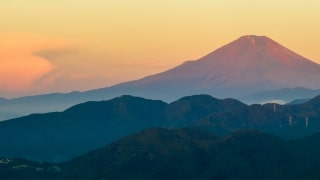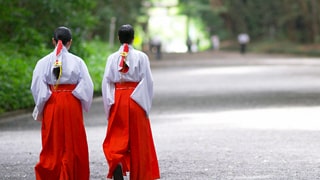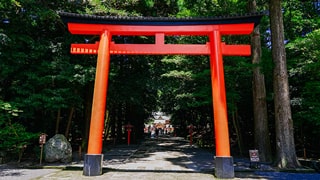Q&A

Shinto Religious Practice
The history of Shinto can be traced back to ancient times. It developed naturally along with the emergence of Japanese culture and life-cycle ceremonies. Shinto does not have a founder.
Yes, to some extent. There are Shinto sects, mostly founded since the nineteenth century, that consider themselves as distinct from other Shinto traditions. However, Jinja Honcho and most jinja in Japan are part of “Jinja Shinto”. Within Jinja Shinto, jinja share a lot of practices and matsuri, and see each other as part of the same tradition, but every jinja has its own special matsuri as well. Many jinja that venerate different kami still identify as part of Jinja Shinto.
Shinto has no scriptures. However, there are several texts that recount the myths of Japan and describe the practices of certain jinja, and these are an important part of Shinto’s shared culture. The most important are the eighth-century history texts known as the Kojiki and Nihonshoki.
The ancient Japanese had a notion that everything in this world was a sacred being and this is why Shinto has an enormous number of deities, known as kami, as objects of reverence. They include not only mythical figures but also Tenno (past Emperors), and historical people. Kami is sometimes translated by the English word “god”. However, the concept of kami is different from the western idea of “god”. Among the numerous kami of Shinto, Amaterasu-Omikami is revered most highly but Shinto has no concept of any one absolute god or of a hierarchy among kami.
There are about 80,000 jinja and around 20,000 priests in Jinja Shinto, while other Shinto sects are much smaller. Some priests take care of more than one jinja, but some jinja have many priests.
Every Japanese person is regarded as a parishioner of a local jinja, no matter whether they are conscious of it. Local jinja are called ujigami and are considered to be guardians of the village. About 80% of the population of Japan visits a jinja at new year, in a custom called hatsumode.
Yes. There are jinja in places where Japanese people have emigrated to such as Hawaii and Brazil. There are also a small number in other countries, such as one in San Marino.
Japanese people frequently go to Shinto jinja to pray or give thanks, but not on any particular day. Also, various rituals and events are held at jinja when people are at major turning points in their lives, such as Hatsumiya-mode (the first visit of a new born baby), Shichigosan (for children aged three, five, and seven) and wedding ceremonies. As mentioned above, a large majority of Japanese people visit a jinja at the beginning of every year, and many go to their local jinja for the main annual matsuri as well.
The main difference is religion. Shinto jinja are for Shinto, and temples are for Buddhism. Each Shinto jinja has a torii at the entrance and this is the main symbol that distinguishes a Shinto jinja from a Buddhist temple.
All jinja are public in the sense that they are open to everyone, and the same is true of most Shinto matsuri. Jinja are also primarily for the whole community of an area, rather than for a limited group of individuals, and so they are public in this sense as well.
However, Shinto plays no political role, nor does it play any role in the ceremonies of the Japanese state. The Japanese constitution requires a strict separation between the state and religion, and this is respected.
Shinto is not the sort of thing that you convert to. You are welcome to practise Shinto, both by visiting jinja in Japan, and in personal practice at home, but there is no equivalent of Christian baptism. Shinto is something that you do, rather than something that you are, and the practice of Shinto is regarded as entirely compatible with adherence to another religion, or with having no religion. Indeed, most people who practise Shinto in Japan would describe themselves as either having no religion, or as being Buddhist.

Priests and Miko
The different colours represent the ranking system for priests based on their experience and qualifications.
The daily duties for both miko and priests begin with the cleaning of the jinja grounds. Following this, a ceremony for the offering of food and drink to the kami is conducted accompanied by a purification ritual for the area and participants. In addition to the daily rites conducted by priests, jinja hold a multitude of ritual events throughout the year. Miko assist the priests in many ceremonies as well as offer amulets. They also perform sacred dance at most large jinja. It is important to note that many jinja do not have miko.
Yes. It is necessary to pass an exam or to complete a special course at a recognised educational institution in order to be qualified as a Shinto priest. The courses take at least a year, and must be taken in Japanese. It is possible for non-Japanese people to become Shinto priests, and a handful have, but the practical hurdles are considerable.
In principle, yes. You need to be female, and generally fairly young (no older than your mid-twenties in most cases, although this depends on the jinja). It is a commitment, and so you need to be in Japan for longer than a few days, and, as a practical matter, you will almost certainly need to speak Japanese. However, many jinja recruit temporary miko for the busy season over New Year, and if you are interested in doing that, you should enquire at a jinja near you, several months in advance. There are no formal qualifications, as there are for priests. At some jinja, it may be possible to serve part-time as a miko over a longer period, but again, you should enquire at your local jinja. At many smaller jinja there are no miko at all for most of the year.

Visiting a Jinja
It represents the border between the secular and the sacred worlds. The outermost torii marks the entrance to the sacred space of a Shinto jinja precinct. At some jinja, there are further torii as one approaches the main sanctuary, marking the entrance to spaces that are even more sacred.
It is usually permitted to take photographs of the buildings and environment, but in some cases or areas it might be forbidden. Please follow the instructions of the jinja staff. Please do not take photographs of people without their permission.
Ise Jingu is a special jinja, and we recommend that you visit it if you have the opportunity. Other jinja are found throughout Japan, each with its own local traditions and individual history. Wherever you are staying in Japan, there will be jinja near you, and this is a perfect opportunity to visit them.
Most jinja do not require an admission fee to enter.
Please be aware that fees may be required to enter certain museums and gardens within the jinja precinct.
Generally, the jinja precinct opens with the sunrise and closes with the sunset throughout the year. For more detailed monthly and seasonal opening hours at major jinja, please refer to their websites.
There are no specific restrictions for visitors of other religions or faiths. It is preferable that you maintain the dignity of the sacred jinja grounds and pay your respects to the kami in a polite and sincere manner.
Most jinja do not accept credit card or e-money payments.
Bringing food or drink into the jinja grounds is not recommended. If there are small food stalls, cafes or vending machines within the jinja grounds please consume the food or drink in the designated areas with respect for other visitors.
There is no strict dress code for visitors but we do recommend, out of respect, that you dress modestly as many local worshippers visit jinja to pray.
At the moment there are no such guided tours. Information on guides can be found from local tourist websites.
Yes, toss some coins in the offering box, bow twice deeply, clap your hands twice, and bow once again. If you wish to make a special prayer, please do so in a quiet and respectful manner after clapping.
Although it is customary to offer some coins in the saisenbako, there is no fixed amount that is required.
Not necessarily. It is uncommon to have many of the same type of omamori from one jinja.
It is preferable to obtain omamori from different jinja, or various omamori from one specific jinja. In this way one can receive protection from numerous kami or many blessings from one particular kami.
There are some, although not many.